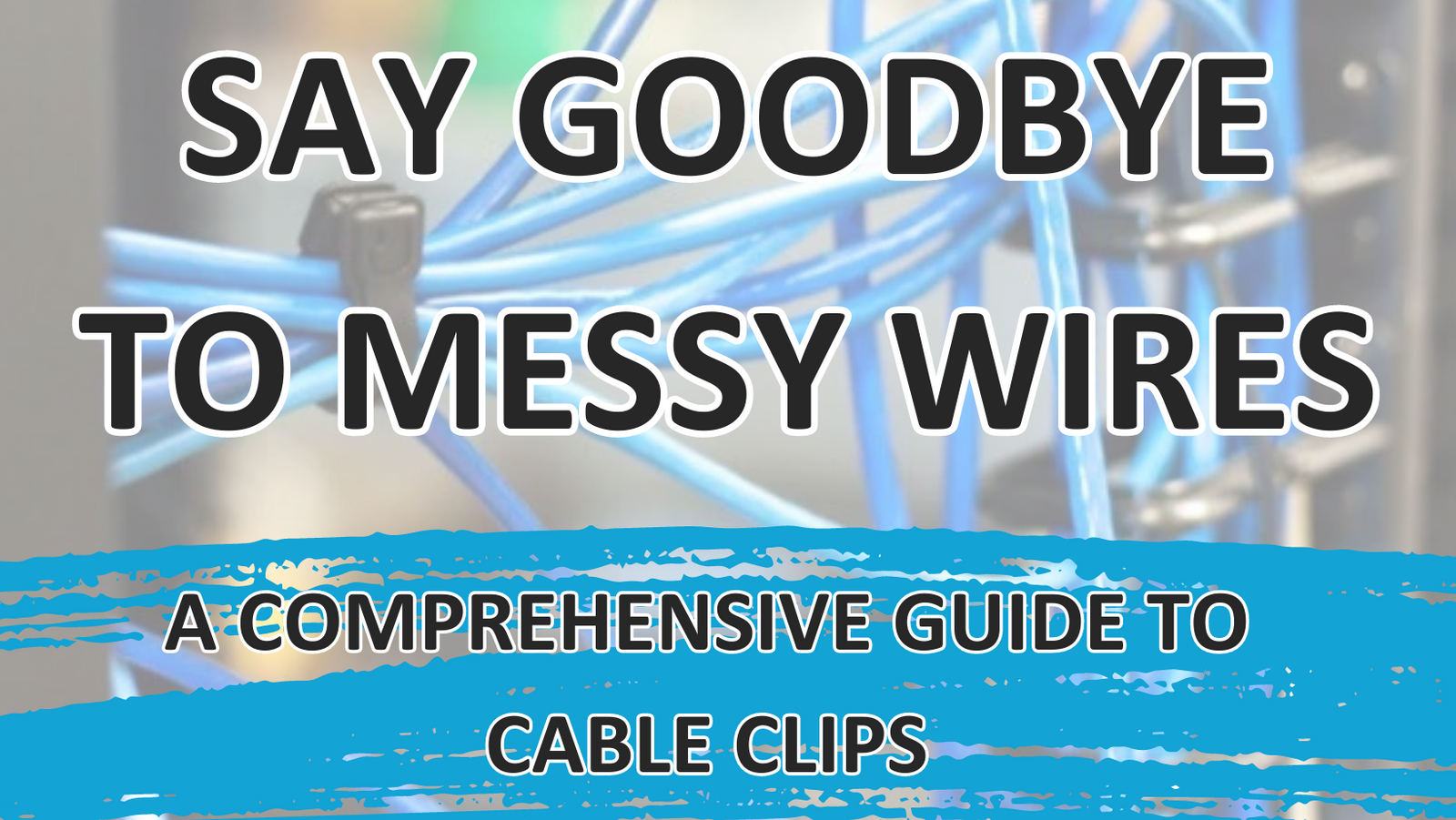- Home
- Products
- Media Gallery
- How it Works
- Blog
- About us
- Sign in
-
United States (USD $)
- Home
- Products
- Media Gallery
- How it Works
- Blog
-
About us
Mastering Cable Tie Installation: Your Ultimate Step-by-Step Guide for Seamless Results
June 07, 2023

Welcome to our guide on cable➰ ties, also known as zip ties!!! Cable ties are a versatile and handy tool for organizing and securing cables, wires, and other items. They come in various sizes, colors, and materials, including stainless steel, plastic, and heavy-duty options. In this guide, we'll cover everything you need to know about using cable ties safely and effectively.
Key Takeaways
- Proper installation of cable ties: Gather materials, prepare cables, select the right size, loop and secure, trim excess length, and organize.
- Recommended spacing for cable ties: Maintain consistent spacing based on cable diameter.
- Looping cable ties together: Use ties of the same length, pull tight, be cautious with heavy objects.
✨ Here's what we'll cover:
- Proper installation of cable ties
- The recommended spacing for cable ties
- How to loop cable ties together
- How to screw cable ties
- How to wrap cables with cable ties
- The most common cable tie size
- How to put two zip ties together to make a longer one
- How to tension steel cable ties
📝 In the next sections, we'll dive deeper into each of these topics to help you become a cable tie pro!
How to Safely Install Cable Ties
Proper cable management not only improves the aesthetics of your setup but also prevents potential hazards. So take some time to install cable ties and enjoy a tidier and more efficient environment. Here’s how to safely install cable ties to keep your cables organized and tangle-free.
Step 1: Gather Your Materials
Before you begin, make sure you have everything you need for the task:
- Cable ties (also known as zip ties)
- Wire cutters or scissors
- A clean and organized workspace
Step 2: Prepare Your Cables
Proper preparation is essential for a successful cable tie installation. Follow these steps:
- Gather all the cables you want to secure and untangle any knots or twists.
- Straighten the cables out to make them easier to work with.
Step 3: Select the Right Size
Choose the appropriate size of cable tie for your cables. Ensure that it is long enough to wrap around the cables but not too long to leave excess length. Using the right size will provide a secure hold without causing any strain on the cables.
Step 4: Loop and Secure
Now it's time to start installing the cable ties. Here's a simple and effective technique:
- Thread the pointed end of the cable tie through the small opening at the opposite end.
- Wrap the cable tie around the bundled cables, forming a loop.
- Insert the pointed end into the opening, creating a secure hold.
- Pull the cable tie tight, but be careful not to overtighten and damage the cables.
Step 5: Trim Excess Length
After tightening the cable tie, trim off any excess length using wire cutters or scissors. This will give your cable management a clean and professional look.
Step 6: Organize and Arrange
Once you have secured the cables with cable ties, organize and arrange them along the desired path. Consider using additional cable ties to keep the cables together at regular intervals for a more organized appearance.
Step 7: Test and Adjust
After completing the installation, it's important to test the functionality of your cables. Ensure that they are still working properly and not strained or pulled too tightly. Make any necessary adjustments to maintain optimal cable health.
By following these simple steps, you can safely install cable ties and achieve a clutter-free and organized space.
Recommended Spacing for Cable Ties 📏🔢
When it comes to using cable ties, proper spacing is important to ensure a secure and stable hold on the cables. Here are some tips for recommended spacing:
🔸 Keep the spacing consistent throughout the length of the cable bundle.
🔸 For cables less than 1 inch in diameter, use a tie every 2-4 inches.
🔸 For cables between 1-2 inches in diameter, use a tie every 4-6 inches.
🔸 For cables larger than 2 inches in diameter, use a tie every 8-10 inches.
Following these guidelines will ensure that your cables are securely held and prevent any unwanted movement.
Looping Cable Ties Together 🔄🔗
Looping cable ties together is a great way to extend their length and secure larger objects. Here's how to do it safely:
- Get two cable ties of the same length and insert the end of one through the head of the other.
- Loop the first tie back around and insert it through its own head.
- Pull tight to create a loop.
- Repeat the process, looping one tie through the other until the desired length is reached.
- Make sure the ties are pulled tight and secure.
🔑 Tips for Looping Cable Ties Together 🔑
- Use cable ties of the same length for a secure fit.
- Make sure the ties are pulled tight to avoid any slippage.
- Use caution when using looped cable ties on heavy objects, as they may not hold up well under extreme weight.
Screwing Cable Ties 🔩🔒
In some cases, it may be necessary to screw cable ties into place to ensure they remain secure.
This method is commonly used in construction and automotive industries. Here are the steps to screwing cable ties:
- Drill a hole where you want to place the cable tie.
- Insert the tail of the cable tie through the hole.
- Pull the cable tie tight and use pliers to hold it in place.
- Screw the cable tie into place using a screwdriver or drill.
- Cut off the excess tail of the cable tie using a flush cut off tool.
It's important to note that not all cable ties are designed to be screwed into place. Be sure to check the manufacturer's specifications before attempting to use this method.
Wrapping Cables with Cable Ties 📦🔗

Wrapping cables with cable ties is a quick and easy way 🔗to organize and secure loose cables.
Whether you're managing a few cords at home or dealing with a massive bundle of cables at work, cable ties can help keep things tidy and safe. Here are some tips for effectively wrapping cables with cable ties:
- Determine the length of the cable ties you need for the job. It's important to use a cable tie that is long enough to wrap around the cables at least once, but not too long that it can't be secured tightly.
- Gather the cables you want to secure and align them neatly. Make sure the cables are not twisted or tangled before wrapping them with cable ties.
- Wrap the cable tie around the cables in a tight loop, being careful not to over-tighten and damage the cables.
- Secure the cable tie by inserting the pointed end into the locking head, and pull the tail until it is tightly wrapped around the cables.
- Trim the excess cable tie tail with a flush cut-off tool.
- Check the tension of the cable tie and adjust if necessary.
- Repeat the process until all cables are secured and organized.
- Cable ties come in a variety of colors and sizes, so you can choose the best one for your needs. Some cable ties even come with a label area for easy identification.
- Remember to avoid wrapping too tightly and damaging the cables, and make sure to leave enough slack in the cables for flexibility and future adjustments.
Most Common Cable Tie Size 📏🔍
When it comes to cable ties, there are various sizes available, but some sizes are more commonly used than others. The most common size of cable tie is 8 inches in length and 0.18 inches in width. This size of cable tie is versatile and can be used for various applications.
Uses of the Most Common Cable Tie Size
Here are some of the uses of the most common cable tie size:
- Organizing cables and wires
- Securing bags or boxes
- Bundling tools or equipment
- Fastening items to a structure
- Temporary fixes for broken items
- Securing plants to a trellis or stake
Overall, the most common cable tie size is a popular choice for a variety of applications due to its versatility and ease of use.
How to Put Two Zip Ties Together to Make a Longer One
This technique opens up new possibilities for organizing and securing cables of varying lengths. Whether you're working on a DIY project or organizing cables in your home or office, extending zip ties will give you the flexibility you need. Get creative and enjoy the benefits of extended cable management today.
Step 1: Gather Your Materials
Before you begin, make sure you have the following materials ready:
- Two zip ties of the same width and thickness
- Wire cutters or scissors (optional)
Step 2: Prepare the Zip Ties
Ensure that both zip ties are clean and free from any debris or obstructions. Straighten them out to make them easier to work with.
Step 3: Insert and Overlap
Follow these steps to connect the zip ties together:
- Insert the pointed end of one zip tie through the head (locking mechanism) of the other zip tie.
- Continue to slide the pointed end through until the two zip ties overlap by a desired length.
- Make sure the teeth on both zip ties are aligned, ensuring a secure connection.
Step 4: Lock the Zip Ties
Once the zip ties are overlapped, lock them in place by pulling the loose end of the first zip tie. This will tighten the connection and prevent it from slipping or coming apart.
Step 5: Trim Excess Length
If desired, you can trim off any excess length using wire cutters or scissors. This step is optional but can provide a cleaner look and prevent any potential snags.
Step 6: Test the Connection
After connecting the zip ties, give them a gentle tug to ensure they are securely fastened together. Double-check that the teeth are properly engaged and that the connection holds without slipping.
By following these simple steps, you can easily connect two zip ties together to create a longer one for your cable management needs.
Tensioning Steel Cable Ties 💪🏼🔗
When it comes to heavy-duty applications, steel cable ties are the go-to option. Tensioning steel cable ties correctly is crucial for a secure and safe installation. Here are some tips to help you get it right:
Use the Right Tool
- Use a cable tie tensioning tool designed for steel ties to ensure proper tension.
- Avoid using pliers or other tools that may damage the tie or leave it loose.
Tighten Gradually
- Tighten the tie gradually to avoid over-tensioning or damaging the cable.
- Begin by hand-tightening the tie until it is snug, then use the tensioning tool to bring it to the desired tension level.
Check the Tension
- Use a tension gauge to ensure the tie is at the correct tension level.
- The gauge will show if the tie is too loose or too tight, allowing you to adjust as needed.
Leave Some Slack
- Avoid over-tightening the tie, as it can damage the cable or create stress points.
- Leave a small amount of slack to allow for cable movement and expansion.
Insights from Reddit Users: Unveiling the Advantages of Tensioning Tools for Tightening Cable Ties

After analyzing Reddit comments, users' opinions on tensioning tools for cable ties vary. Some praise their effectiveness and efficiency, while others find them slower and cumbersome. Certain users highlight precise tensioning benefits, and a small percentage suggests alternative methods. Stay tuned for our upcoming blog post, where we'll discuss pros, cons, tips, and alternative techniques for mastering cable management practices. Get ready to make informed decisions on the right tools for you! Dive into our comprehensive guide on benefits, types, and pro tips below. 🛠️💡
Using Cable Tie Hand Tools 🔧🛠
Cable tie hand tools can help to make the process of tying cables faster and easier. These tools are specially designed to tension and cut cable ties with minimal effort. There are different types of cable tie hand tools available in the market, and each of them has its own unique features.
🛠️ Benefits of using cable tie hand tools:
- They help to achieve a tighter and more secure tie
- They reduce the risk of damaging the cables or wires
- They improve the speed and efficiency of the process
- They are ergonomically designed to reduce hand fatigue
🛠️ Types of cable tie hand tools:
- Cable tie tensioning tools: These tools are used to tighten the cable tie around the cables or wires, ensuring a tight and secure tie.
- Cable tie cutting tools: These tools are used to cut the excess length of the cable tieafter tightening it.
- Combination tools: These tools are a combination of both tensioning and cutting tools, making them more versatile.
When using cable tie hand tools, it's important to follow the manufacturer's instructions carefully. Here are some general tips for using cable tie hand tools:
🛠️ Tips for using cable tie hand tools:
- Choose the right tool for the job
- Ensure that the tool is properly calibrated before use
- Place the cable tie in the tool's jaws, and pull the trigger or handle to tension the tie
- Use a cutting tool to remove the excess length of the tie
Always wear appropriate personal protective equipment, such as gloves and eye protection
Wrapping Up 🎉✅

Cable ties🔌 are versatile and convenient tools for organizing and securing wires, cables, and other items. With the right knowledge and techniques, you can use cable ties to organize your workspace, secure items during transportation, and even create DIY projects.
In this article, we've covered everything you need to know about cable ties, including the different types, sizes, and materials. We've also shared tips and tricks for using cable ties effectively and safely, as well as alternative solutions for when cable ties aren't the best option.
Remember, always choose the right size and strength of cable tie for the job, and make sure to properly tension them for optimal security. By following these guidelines, you can make the most out of your cable ties and keep your space organized and safe.
For your upcoming cable installation requirements, our extensive Guide on Cable Management Ideas and Tools will be invaluable.
Frequently Asked Questions
What are the different names for cable ties?
Cable ties are also commonly known by several other names, including:
- Zip ties
- Wire ties
- Cable fasteners
- Tie wraps
- Hose ties
- Cord fasteners
- Cable straps
- Nylon ties
- Plastic ties
- Baler wraps (in agricultural applications)
- Ty-Rap
- Wire Wrap
- Mouse Belt
- Rat belt
- Strap
- Cable fixer
- Cable tie wrap
- Cable attachment
- Cable clip
- Cable lasher
- Cable link
- Clamping collar
- Clamping ring
- Clamping strap
These different names may vary depending on the manufacturer or the specific use of the cable tie. These terms are often used interchangeably to refer to the same type of fastening device used for bundling and securing cables, wires, and other items.
What is the difference between cable ties and zip ties?
Cable ties and zip ties are two terms that are often used interchangeably, but there are some subtle differences between the two..
Zip Ties:🔗
- Zip ties are a type of cable tie that are commonly used in the United States and Canada.
- They are made of nylon and come in a variety of colors, including white and black.
- Zip ties have a small toothed mechanism that locks the tie in place and prevents it from slipping.
Cable Ties:
- Cable ties are the generic term for any type of tie used to secure wires and cables.
- They can be made of various materials such as nylon, stainless steel, or plastic.
- Cable ties typically have a wider range of sizes and strengths than zip ties.
In summary, while zip ties are a specific type of cable tie made of nylon with alocking mechanism, cable ties are the more general term for any type of tie used to secure wires and cables.
How many wires can I zip tie together?
The number of wires🔌 that can be zip tied together depends on the size of the zip tie and the thickness of the wires. It is important to not over-tighten the zip tie to avoid damaging the wires. Generally, it is recommended to bundle a maximum of 12-15 wires together with a zip tie to ensure they are secured without being damaged. It is also recommended to use multiple zip ties for larger bundles of wires to ensure they are properly secured.
What is the difference between white and black zip ties?
The primary difference🤔 between white and black zip ties is their level of UV resistance. Black zip ties are typically more resistant to UV radiation and are designed for outdoor use or other environments with significant sun exposure. White zip ties, on the other hand, are more prone to breaking down over time when exposed to UV radiation and are typically recommended for indoor use. Additionally, black zip ties may be preferred in some applications where they need to blend in with the surrounding environment, while white zip ties may be more visible and easier to spot.
What is the hole in the cable ties for?
The hole🕳️ in cable ties is used to anchor or mount the tied object onto a surface using a screw or a nail. This feature allows for a more secure and permanent attachment of the object. Additionally, the hole can also be used to bundle multiple cable ties together for a more organized and neater appearance.
How do you tension metal cable ties?
To tension metal cable🔌 ties, follow these steps:
- Position the cable tie around the wires or object you want to secure.
- Insert the tail of the cable tie into the locking mechanism on the head.
- Use a cable tie tensioning tool, such as pliers or a tensioning gun, to pull the tail of the cable tie until it is tightly secured around the wires or object.
- Once the cable tie is tensioned, use a cable tie cutter or snips to cut off the excess tail of the cable tie.
It's important to use the appropriate tensioning tool to ensure that the cable tie is not over-tightened, which can damage the wires or object being secured, or under-tightened, which can result in the cable tie slipping and becoming loose over time.
What is a cheaper alternative to zip ties?
One cheaper alternative✅ to zip ties is using twist ties, which are made of a thin, flexible wire covered in paper or plastic.. They are commonly used for bundling items such as cords, cables, and bags. Another alternative is using reusable hook and loop fasteners, such as Velcro strips, which can be used multiple times and adjusted as needed. Additionally, some people use simple twine or string to tie things together, although these may not be as durable or secure as other options..
Should you zip tie wires together?
Yes, zip tying wires🔌 together can be a convenient and effective way to organize and secure them. However, it is important to make sure that the wires are not too tightly bound, as this can cause damage or even breakage. Additionally, it is important to use the appropriate size and type of zip tie for the wires being secured, to prevent damage or safety hazards.
How do you cleanly tie cables together with zip ties?
To cleanly tie cables🔌 together with zip ties, follow these steps:
- Choose the right size zip tie for the cables you want to tie together.
- Gather the cables together and arrange them neatly, making sure they are all aligned.
- Thread the zip tie through the hole, making sure the ridged side is facing inward.
- Pull the zip tie tight, but not too tight that it damages the cables.
- Trim off the excess with a pair of wire cutters or scissors, making sure to leave a little bit of the tail so that it can be adjusted if necessary.
By taking your time to neatly arrange the cables and trimming off the excess, you can create a clean and organized look.
Leave a comment
Comments will be approved before showing up.
Also in Cloop Blog

Say Goodbye to Messy Wires: A Comprehensive Guide to Cable Clips
August 20, 2023
This article provides a comprehensive guide on cable clips, including types of cable clips, how to attach cables to a wall without nails, choosing the right size cable clip, proper cable clip installation, and references for further reading. It also includes practical tips, anecdotal evidence, and unique content to engage readers. The article aims to help readers organize their cables and improve the aesthetics and functionality of their spaces.

Supercharge Your Daily Commute: Maximize Productivity with These Game-Changing Tips
August 20, 2023
Magnetic cable ties are a convenient and efficient solution for organizing and managing cables during your daily commute. They simplify cable management, save time and effort, and offer reusability. These ties are versatile and can be used for various applications beyond cable management. They are durable, safe, and have an innovative design. In comparison to traditional cable ties, magnetic cable ties offer advantages such as reusability, adjustability, safety, versatility, durability, cost-effectiveness, and a sleek appearance. By incorporating magnetic cable ties into your daily routine, you can enhance productivity and optimize your commute experience.

Unleash Cable Bliss with Magnetic Cable Ties: Key Features and Benefits Revealed!
August 20, 2023
In this blog post, we delve into the world of magnetic cable ties and explore their remarkable features and benefits. These innovative tools offer a solution to the perennial problem of tangled cables, providing a convenient and secure way to keep your cords organized. From their strong magnets and quick lock/release mechanism to the cable passage design that ensures cables stay attached, magnetic cable ties are a game-changer. We also provide practical tips for cable bliss, such as storing cables without tangling and using zip ties effectively. Testimonials from satisfied users add a personal touch, and we offer ideas for creating your own cable oasis. Say goodbye to cable chaos and welcome a tidier and more organized life with magnetic cable ties.
Sign up to get the latest on sales, new releases and more…

